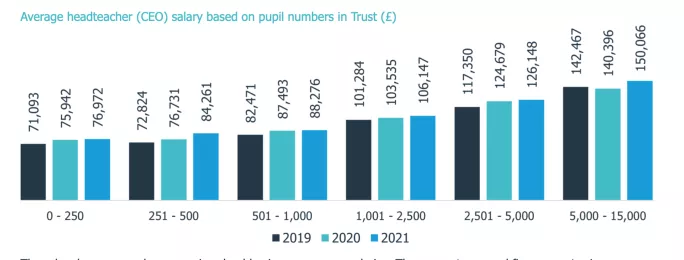Pay for CEOs of largest MATs rises £10k on average

Chief executive salaries at the largest multi-academy trusts (MATs) increased by around £10,000 on average in the past year, according to a survey.
Findings published today show that average salaries for MAT leaders in trusts responsible for more than 5,000 pupils have increased from £140,396 in 2020 to £150,066 last year - a 6.8 per cent rise.
The Kreston Academies Benchmark Report also shows that costs saved during the last national lockdown have helped academy trusts to achieve record surpluses in 2021 - though the report does explain that this situation will likely be temporary, with the cash expected to go towards catch-up and rising operational costs.
- Academies: Number of schools converting falls by half
- DfE: Primary schools fear losing autonomy through academisation
- Need to know: DfE’s plan for academies
The annual report, now in its tenth year, is based on survey findings from more than 300 multi- and single-academy trusts representing more than 1,500 schools.
Here is everything you need to know about the findings.
1. Average £10,000 salary increase for larger MAT leaders
The report shows that, on average, leaders of the largest MATs surveyed have seen a salary increase that is proportionally greater than the sector as a whole.
Overall, the average salary of MAT leaders and heads of primary single-academy trusts in the survey have increased by 4.5 per cent in 2021.
The average salary of heads of secondary single-academy trusts has increased by 2.6 per cent.
But the report also provides the average headteacher or chief executive salary for academy trusts broken down by the number of pupils they are responsible for.

It shows that leaders of the largest trusts in the survey - with between 5,000 and 15,000 pupils - have seen an average salary increase of 6.8 per cent from 2020 to 2021, from £140,396 to £150,066.
This is in contrast to last year, where the average salary of leaders in these larger trusts actually fell compared with the previous year.
But the biggest percentage salary increase in today’s report was in trusts serving between 251 to 500 pupils, rising from £76,731 to £84,261 (9.8 per cent).
Commenting on leadership pay, the Kreston report said: “After several years of restraint, this needs to be carefully monitored by trusts as the Education and Skills Funding Agency continues to pay close attention to leadership pay.”
2. Trusts have saved money during the pandemic
The report also shows that the Covid lockdown in 2021 has helped academy trusts to achieve another record year of surpluses.
It reveals that the average in-year financial surplus for a MAT doubled to more than £460,000 in 2021, up from £221,000 in 2020.
This continues a trend that the Kreston report identified in academies in 2020 following the first national lockdown.
The report said: “To put the results into context, the 2020 numbers were the largest surpluses we had seen in the 10 years of producing this report. The 2021 figures are showing even larger surpluses, and so is another record-breaking year.”
The report said academy trust cash balances have been bolstered through the injection of government funding earmarked for Covid testing, education catch-up programmes and other Covid-related costs that schools have not yet had the time or capacity to spend because of the pandemic.
It said the surpluses have also been strengthened by the cancellation of exams and the reduced costs associated with utilities, staffing and maintenance, due to schools not being fully open during lockdown
3. Warning that recovery could swallow up surpluses
The report suggests these high surpluses will be needed to help fund the recovery effort from Covid.
Pam Tuckett, chair of Kreston International’s academies group and head of education at accountants Bishop Fleming, said: “There’s no denying that on paper, multi-academy trusts have had a record-breaking year in terms of their financial health. But the story behind the data reveals a much more complex picture.
“Government funding to cover Covid testing, additional staffing and other costs relating to the pandemic have largely not been spent as time constraints saw existing school staff bear the burden of introducing new measures to support pupils and tackle the spread of the virus.
“This money will be swiftly invested to address the colossal toll the pandemic has had on pupils’ education and wellbeing.
“Additional spending resulting from rising inflation, soaring energy prices and the increased cost of plugging staff shortages will rapidly eat into financial gains across the sector too.”
4. Only one in seven MATs pool school funding, but the trend is increasing
The report shows that an increasing number of MATs are carrying out the practice known as “GAG pooling” - moving schools’ general annual grant funding into a central pot and then redistributing the money back to schools.
However, only one in seven trusts surveyed in the Kreston report were doing this last year.
The report says that it first identified the practice of GAG pooling in 2017 and has seen it increase year on year.
In today’s report for 2021, 14 per cent are identified as GAG pooling - up from 11 per cent in 2020 and 5 per cent in 2019.
5. Most MATs plan to keep growing
MATs featured in the report have continued to grow in the last 12 months, with the average size of a trust increasing from 6.8 schools last year to 7.5 in 2020-21.
Nearly 65 per cent of trusts reported expected growth in 2022-23, with 57 per cent forecasting up to three additional schools joining their group.
Just over a third of trusts (35 per cent) are expecting no growth, while 6.5 per cent expect to grow by between four to six schools.
Leora Cruddas, chief executive of the Confederation of School Trusts, said: “The fact that MATs have expanded over the last 12 months of Covid disruption is testament to the huge amount of work and effort trusts and schools have put in to supporting this while juggling many other priorities.”
6. Trusts predict having less money in three years’ time
The Kreston survey showed that 61 per cent of trusts predicted their reserves will be lower in three years’ time, compared with 14 per cent of trusts that predicted the level would remain the same.
Ms Tuckett added: “We found that trusts with a maximum of 10 schools were much more likely to expect reserves to have reduced by 2025 than those with 11 or more schools, reflecting the economies of scale achievable in a larger trust.”
7. MATs are more centralised
The report says that 97 per cent of MATs are now either fully or partially centralised and that this approach has been increasing over time.
It classes trusts as fully centralised when areas such as finance, human resources or school improvement are managed at trust level.
The report said only 3 per cent of trusts featured in the report do not follow a model based on centralisation.
Fully decentralised MATs tend to be small with very few schools, it added.
You need a Tes subscription to read this article
Subscribe now to read this article and get other subscriber-only content:
- Unlimited access to all Tes magazine content
- Exclusive subscriber-only stories
- Award-winning email newsletters
Already a subscriber? Log in
You need a subscription to read this article
Subscribe now to read this article and get other subscriber-only content, including:
- Unlimited access to all Tes magazine content
- Exclusive subscriber-only stories
- Award-winning email newsletters
topics in this article



